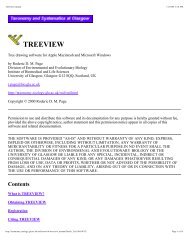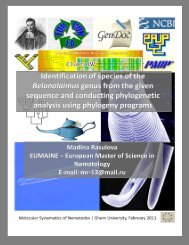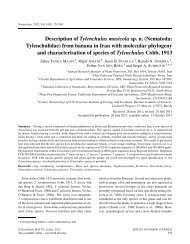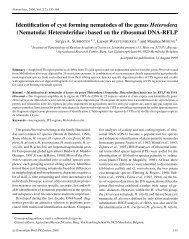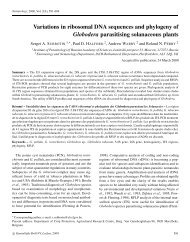Radopholus arabocoffeae sp. n. (Nematoda ... - Donimabe.org.vn
Radopholus arabocoffeae sp. n. (Nematoda ... - Donimabe.org.vn
Radopholus arabocoffeae sp. n. (Nematoda ... - Donimabe.org.vn
You also want an ePaper? Increase the reach of your titles
YUMPU automatically turns print PDFs into web optimized ePapers that Google loves.
P.Q. Trinh et al.<br />
Filipjev & Schuurmans Stekhoven, 1941), are recognised<br />
as being re<strong>sp</strong>onsible for serious crop losses on both Coffea<br />
arabica L. and C. canephora Pierre ex Froehner.<br />
Whitehead (1968) commented on the great importance of<br />
<strong>Radopholus</strong> similis (Cobb, 1893) Thorne, 1949 to coffee<br />
in Java as reported by Zimmerman (1898). This nematode<br />
was considered to be the most harmful nematode<br />
to that country and second only in importance to P. coffeae.<br />
Holdeman (1986) cited coffee as one of the 365 host<br />
plants for R. similis.<br />
Siddiqi (2000) recognised 20 valid <strong>sp</strong>ecies of <strong>Radopholus</strong><br />
Thorne, 1949. Since then, R. musicola Stanton,<br />
Mundo-Ocampo, Baldwin & Kaplan, 2001, has been described<br />
from Musa acuminata in Australia (Stanton et al.,<br />
2001) and Nguyen et al. (2003) described R. duriophilus<br />
Nguyen, Subbotin, Madani, Trinh & Moens, 2003 from<br />
durian (Durio zibetinus M.) in Vietnam. Species of the<br />
genus <strong>Radopholus</strong> are indigenous to Australasia where<br />
they live mostly as parasites of wild plants and forest<br />
trees. Sher (1968) reported that of the 22 <strong>sp</strong>ecies then regarded<br />
as valid, only one, viz. R. nigeriensis Sher, 1968,<br />
was indigenous outside of this region. Siddiqi (1991) subsequently<br />
transferred this <strong>sp</strong>ecies to the new genus, Zygradus<br />
Siddiqi, 1991. Since the genomic variation within<br />
a <strong>sp</strong>ecies or genus is likely to be greatest at its centre of<br />
origin, and because at that time two more new <strong>sp</strong>ecies (R.<br />
citri Machon & Bridge, 1996 and R. bridgei Siddiqi &<br />
Hahn, 1995) had been described from Indonesia, Siddiqi<br />
and Hahn (1995) stated that Australasia was probably the<br />
centre of origin of the genus <strong>Radopholus</strong> and therefore<br />
probably the origin of its type <strong>sp</strong>ecies, R. similis.<br />
During a survey of coffee plantations in the Dak Lak<br />
province of Vietnam, two populations were collected that<br />
met the description of the genus <strong>Radopholus</strong> according<br />
to Siddiqi (2000). The population from C. canephora<br />
was attributed to R. duriophilus, but the morphology,<br />
morphometrics and ITS-DNA sequences of the population<br />
from C. arabica cv. Catimor revealed that it belonged<br />
to a new <strong>sp</strong>ecies. This <strong>sp</strong>ecies is herein described as<br />
<strong>Radopholus</strong> <strong>arabocoffeae</strong> <strong>sp</strong>. n. We also report on the<br />
multiplication of this new <strong>sp</strong>ecies in carrot disks and on<br />
its mode of multiplication. Finally, we demonstrate its<br />
damage potential on C. arabica cv. Catimor seedlings and<br />
compare it with that of R. duriophilus and P. coffeae.<br />
Materials and methods<br />
NEMATODES<br />
Female, male and juvenile <strong>sp</strong>ecimens of the R. <strong>arabocoffeae</strong><br />
<strong>sp</strong>. n. population were obtained from roots and soil<br />
of coffee, C. arabica cv. Catimor, sampled in the Krongnang<br />
District, Dak Lak province, Western Highland, Vietnam.<br />
This population was compared with the population<br />
of R. duriophilus collected from the roots and rhizo<strong>sp</strong>here<br />
of C. canephora in Krong Ana District in the Highlands,<br />
and with a population of Pratylenchus coffeae collected<br />
from C. arabica cv. Catimor grown in Dak Lak, Vietnam.<br />
The nematodes were extracted from soil by decantation<br />
followed by centrifugal flotation and from roots by maceration<br />
and centrifugation (Coolen & D’Herde, 1972). All<br />
populations were maintained on carrot disks (O’Bannon<br />
& Taylor, 1968) and used for further observations.<br />
MORPHOLOGY AND MORPHOMETRICS<br />
Individuals from both <strong>Radopholus</strong> populations were<br />
heat killed, fixed in TAF (Seinhorst, 1959), and processed<br />
to and mounted in anhydrous glycerine (Hooper & Evans,<br />
1993). From each population, morphometrics of 20 females<br />
and 20 males were taken using a drawing tube attached<br />
to an Olympus CH40 light microscope.<br />
For scanning electron microscopy (SEM), <strong>sp</strong>ecimens<br />
preserved in anhydrous glycerine were transferred to a<br />
drop of 4% formalin. A subsequent ultrasonic treatment<br />
(10 min) removed particles adhering to the body surface of<br />
the <strong>sp</strong>ecimen. The nematodes were dehydrated by passing<br />
them through an ethanol gradient of 25 (overnight), 50,<br />
75, 95 (3 h each) and 100% (overnight) at 25 ◦ C. They<br />
were critical point dried with liquid CO 2 , mounted on<br />
stubs, and coated with gold-palladium (25 nm) before<br />
observation with a Jeol LSM-840 at 15 kV.<br />
MOLECULAR STUDIES<br />
DNA was extracted and amplified from both <strong>Radopholus</strong><br />
populations as described by Waeyenberge et al.<br />
(2000). Forward primer 5 ′ -CGTAACAAGGTAGCTGT-<br />
AG-3 ′ and reverse primer 5 ′ -TCCTCCGCTAAATGATA-<br />
TG-3 ′ (Ferris et al., 1993) were used for amplification<br />
of the ITS regions, including the 5.8S gene plus flanking<br />
areas of the 18S and 28S genes of rDNA. Amplified<br />
products were excised from 1% TAE-buffered agarose<br />
gels using the Qiaquick Gel Extraction Kit (Qiagen-<br />
Westburg, Leusden, The Netherlands), cloned into the<br />
pGEM-T vector and transformed into JM 109 High Efficiency<br />
Competent Cells (Promega, Leiden, The Netherlands).<br />
Five colonies of each population were isolated<br />
using blue/white selection and submitted to PCR with<br />
vector primers. Amplified product was purified using a<br />
Qiagen Gel Purification Kit (Qiagen). DNA fragments<br />
682 Nematology



